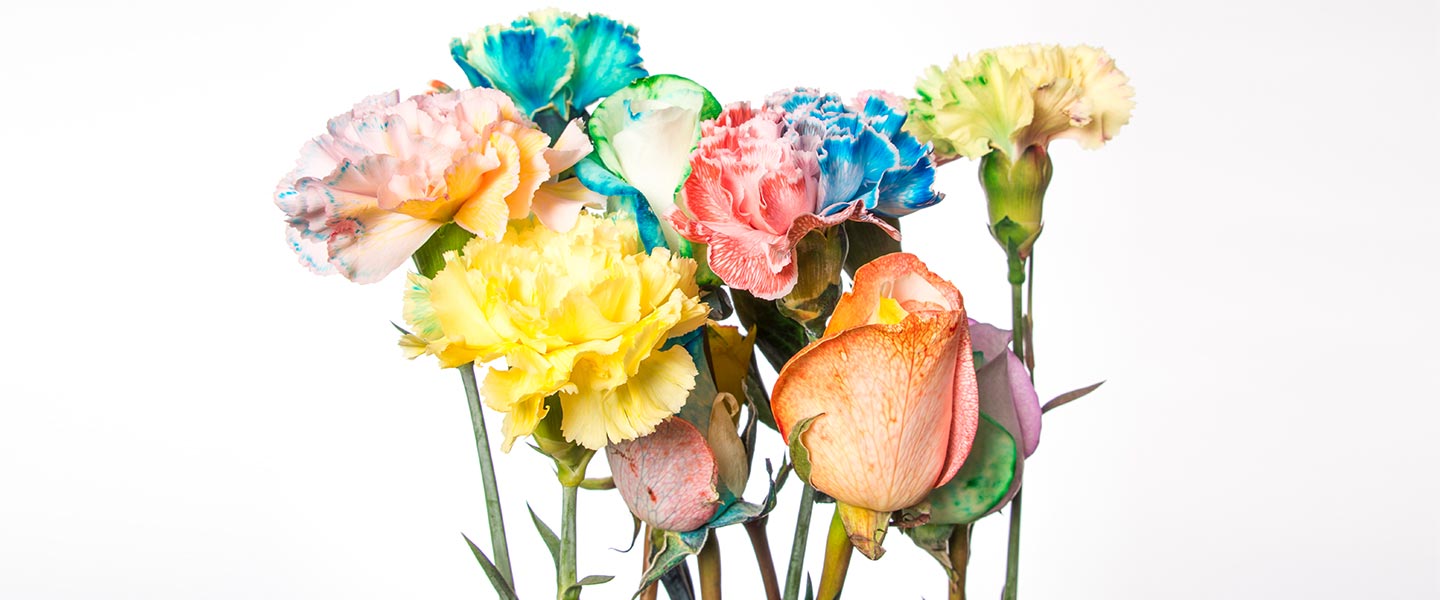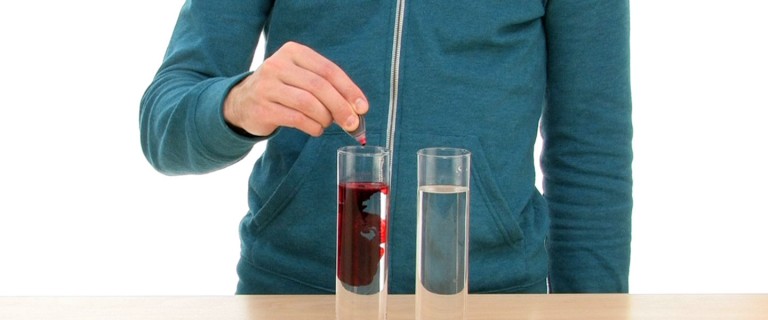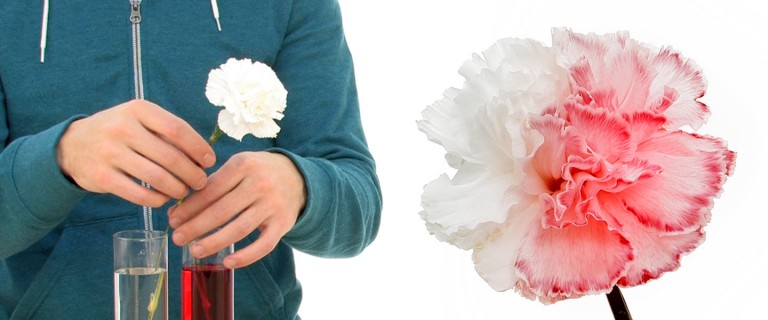Carnation Food Coloring Do You Need Light

Color Changing Carnation Flowers – Science Experiment
Where does the water really go when a plant is watered?
Color Changing Carnation Flowers Science Experiment
Where does the water really go when a plant is watered?
In this color changing flowers science project, you will discover for yourself how essential the stem's function is to plant growth. You will use everyday objects from your home in this carnation flower experiment and learn how to "dye" flowers with food coloring. By adding food coloring in water diffusion, you'll soon see an amazing array of color changing flowers in our amazing science project. As the colored water is absorbed, you will be able to see how the food coloring moves up the stem and into the flower. Be prepared to be amazed when the petals of a white carnation change color! Instead of plain old white flowers, you'll see flowers of different colors when you perform this color changing flower experiment. Cool, huh?
SICK Science® is a registered trademark of Steve Spangler, Inc. All Rights Reserved.
Experiment Materials
- 4 long-stem, white carnations
- 7 Tall plastic cups or vases
- Package of food colorings
- Sharp knife (You'll need an adult helper.)
- Water
Experiment Videos
Experiment

1
Part A
Before placing any of the flowers in water, have an adult trim about 4" (10 cm) off of each stem. Use a knife and cut at an angle. Keep all the flower stems in plain water for now. (Many gardeners and florists even cut stems under water so no air bubbles can get in to break the tube of water and cause wilting. It's important that the stem tubes always be filled with water. If air gets into the tube, water may not be able to move up the stem to the flower.)
Part B
Have an adult use a sharp knife to slit the stems of three of the flowers straight down the middle. Keep them in the plain water for now.

2
Fill five of the cups with different colors of water. Fill the other two with uncolored water.

3
Part A
This step is often called "Split Ends." Place each half of a stem into a cup of different colored water. For example, position the red and blue cups next to each other and put a stem half into each color. Use a color with one of the cups of uncolored water, too. Make a few predictions: Which color will be soaked up? Will the colors mix to make a new color in the petals or will the color in the flower be divided in half?
Part B
Place the last white carnation into the remaining cup of uncolored water. This one is your control flower. Let all the flowers sit and soak for several days. As you wait to see the results, make some more predictions: How will the carnation in the plain water compare to the carnations in the colored water? Which color will be soaked up first? How long will it take? Which color will create the darkest shade in a flower? Which color will create the lightest shade in a flower? Which color might not be absorbed?
How Does It Work
Most plants "drink" water from the ground through their roots. The water travels up the stem of the plant into the leaves and flowers where it makes food and helps keep the plant rigid. When a flower is cut off of its plant, it no longer has its roots; the stem of the flower still "drinks" up the water and provides it to the leaves and flowers. How does this happen?
There are two principles at play that move water through the stems of plants: transpiration and cohesion. Water evaporating from the leaves, buds and petals (transpiration) pulls water up the stem of the plant. (This works sort of like when you suck on a straw.) Water that evaporates from the leaves "pulls up" other water molecules behind it to fill the space it left. Instead of a mouth providing the suction, it is caused by the evaporating water. This can happen because water sticks to itself (cohesion) and because the tubes in the plant stem are very, very tiny. This water movement process through the tiny tubes is called "capillary action."
Coloring the water with food coloring in this color changing flower experiment does not harm the plant. It does, however, allow you to see the movement of water into the flower. Splitting the stem simply proves that the tiny tubes in the stem run all the way through the stem — from the water to the petals of the flowers. Our unofficial tests indicated that the blue food color traveled up the stem and into the carnations the fastest, followed by the red and then the green food color.
Added bonus: You've also just learned how to dye carnations with food coloring. This is a fun way to wow your friends or decorate your home with colorful flowers!

Science Fair Connection
Our Steve Spangler Science Color Changing Carnations science project makes a great science fair activity. Why? Our color changing carnations experiment is a good science fair project because you first start with a control, which is the scientific way of describing the one thing that doesn't change throughout the entire science experiment. In this case, the control is a carnation (or carnations) in the plain, uncolored water.
You then test a "variable." The variable in this color changing flower experiment is the one thing that changes in the experiment. Here, you will change the color of the liquid. You will then make observations and comparisons between the control flower and the flower that has been exposed to the variable. You can then think of another idea to test — like splitting the stem in half or testing one or two colors at once — and you then make some more comparisons. So, if you wanted to make this color changing carnations experiment your own science fair project, what other questions could you ask? These suggestions may give you some ideas:
- What would happen if you changed the way you colored the liquid? Instead of using food coloring in water diffusion, you can test a colored drink like a red fruit punch, a mixed powdered drink or a colored energy-boost drink. How might the way in which you color the water make a difference?
- What would happen if you put the carnation stem into soda instead of water? What if you used a clear soda for one side of the flower and a dark soda for the other side? How might that appear in the flower?
- If you take the carnation out of the cups, do both sides of the flower dry up? What happens to the colored side? Does the color disappear as it dries up? What happens to the color as the flower dries?
- What if you put one carnation in regular water and one carnation in water mixed with fertilizer?
- What if you put one side of the flower in regular tap water and one side in salt water? What will the flower look like?
There are all kinds of questions about carnations that you could explore for a science fair project.
Just remember to change and test only one variable at a time. Compare the effect of that variable to the control flower, document your discoveries and then come with some conclusions about plants and how they absorb liquids. Prepare your presentation and get ready to share your research with everyone who attends the science fair.
Steve Spangler Online Science Experiments for Kids
Love this color changing flower experiment science project? We have a whole collection of Steve Spangler Science online science experiments for you to explore. From this carnation flower experiment to how to make slime and how to float eggs, you'll find a huge variety of hands-on experiments that you can try at home — with a responsible adult, of course! Check out our top five Steve Spangler Science experiments or visit our at-home science kits for fun science projects for kids that will keep their minds active.
Carnation Food Coloring Do You Need Light
Source: https://www.stevespanglerscience.com/lab/experiments/colorful-carnations/